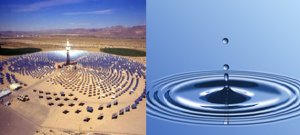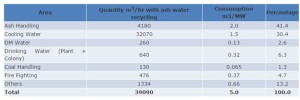
At first an interesting fact, as per the American Wind Energy Association, to generate 1 KW hour of electricity from nuclear power 2.3 litres of water are used on the other hand coal to generate 1 KW hour of electricity needs 1.9 litres and oil needs 1.6 litres respectively. While solar power and wind energy are green but both need water for production of electricity. Solar power plants, whether they are Concentrating Solar Power (CSP) or Photovoltaic Systems (PV) based; generate pollution-free electricity and the amount of water they use is much less compared to other traditional fossil fuel based electricity generating systems.
The sun as an energy source helps generate clean and sustainable electricity without spreading toxic pollution. The only environmental impact resulting out of solar power are use of huge tracks of land, habitat loss, use of water consistently over long period, and use of hazardous materials in manufacturing photovoltaic (PV) solar cells. Water use depends on solar plant design/location, and type of cooling system. According to estimates for utility-scale PV systems need 3.5 to 10 acres per MW, while CSP facilities need 4 to 16.5 acres per MW. Smaller scale solar PV arrays, that can be built on homes or commercial buildings, also have minimal land use impact.
Water as a natural resource which is important to life and sustainable development. However, as a scarce resource its management is important too. India with over 17% of world’s population has just about 4% of global renewable freshwater resources. As it is known global warming, prolonged drought, environmental damage, excessive usage call for the sustainable management of freshwater resources’ in India. While most nuclear plants use up sea water for energy generation and transmission, coal based power plants use maximum freshwater resources, compared to solar power plants that use very little water. Only wind based power plants use water less than solar power plants.
Water Consumption by Coal and Other Power Sources in India
A Greenpeace report ‘The Great Water Grab’ says a 500 MW coal power plant in India with cooling tower, sub critical at 85% capacity factor consumes 8.4 million cubic metres of water per year. Compared to that usage of water by renewable sources of energy is negligible. As per a technical study conducted in 2014, the usage of water in various power plants for various purposes in India are as follows:-

The usage of water at various power generation plants are as follows:-

Water Consumption by Wind Energy and Solar Power

So does it mean solar power doesn’t affect continuous water supply. Nope, on the contrary studies show solar panel manufacturing and its disposal creates toxic waste that affects freshwater supplies. When end-of-life solar panels are sent to landfills, toxic materials like lead or cadmium can seep and pollute groundwater. Aware of the facts, associations like the Silicon Valley Toxics Coalition are working towards reducing these toxic materials through responsible recycling practices while disposing off solar panels.
Why Water Management is Important in India
Considering fact that water availability is getting increasingly reduced and also the cost of water is increasing.
1. Many regions of India are facing water scarcity which is expected to grow more acute as demand of water for use in power generation, industrial production, agriculture and municipal works are set to increase further.
2. As it is known thermal power plants need massive amount of water for cooling as well as power generation. As such setting up new thermal plants is getting increasingly difficult due to shortage of unending water source.
3. India faces scarcity of water due to variety of reasons, as such management of water resources for a variety of uses including irrigation, gardening, housing, and many more has become very important.
4.Many water resource management projects are being implemented including rainwater harvesting, water recycling, sludge water treatment, water percolation project, drip irrigation projection, water sprinkling project.
5. Proper water utilization can also help in improving the performance, availability & reliability by proper treatment/selection of treatment technology thus providing an incentive to power stations.
Impact of Solar Power on Water as Resource
As the world moves away from fossil fuels towards cleaner/greener energy sources like solar power it must be kept in mind that not solar power but solar panel production can impact water as a resource. The production of solar photovoltaic panel makes use of chemicals that are caustic and toxic, as such there is always risk of some kind of chemical spill contaminating the water. Photovoltaic solar panels need to be washed regularly so that their efficiency is maintained. Large solar farms use significant amount of water for cooling/cleaning purposes, and if built in arid areas it can put place great strain on fresh water resource in that region. The only way out, is by improving or modifying existing technology or develop new ones.
For large solar power plants efforts are on to opt for the efficient wet or dry cooling or even wet-recirculating as it may help cut water consumption considerably. However, it may lead to loss of efficiency and increase in production costs. Photovoltaic cells, especially thin-film cells, contains hazardous chemicals. While they pose no risk when in use, but what to do with solar cells are damaged and old? How can they be recycled or disposed of? In case of CSP or trough technology based solar plants use of water is around 3.6 litre / KiloWatt hour. Heliostat and other CSP technologies use far less water. Solar farms use 110 millilitres per KW/hour for cleaning solar panels.
Vivaan Solar Uses Only Rain Water as Resource

In keeping with the policy decision of not to use existing ground water/fresh water resources, Vivaan Solar has built 2 check dams at the Kadodiya Solar Park. Kadodiya Solar Park, its largest single solar farm established till date with current power generation capacity of 45 MW; makes use of these 2 check dams to harvest the rain water. The water collected via rainwater harvesting process is used for cleaning the solar panels all throughout the year round. This way Vivaan Solar makes no use of ground water resources. Also with rainwater harvesting done by Vivaan Solar, it is believed that the ground water level will rise in due course of time.
Not just that Vivaan Solar ensures that even after cleaning the solar panels the water does not go waste. As such, Vivaan Solar has planted Jatropha plants all around the Kadodiya solar park. Once the cleaning is done, the water is directed towards the Jatropha or Jatropha Curacus or Barbados Nuts. As its known fact that seeds of Jatropha plant, contains oil that can be effectively used as biodiesel. It has given Vivaan Solar on opportunity to develop a alternative source of energy that generates additional revenue. Vivaan Solar expects that it will inspire other solar farms to adopt the same model and not just save precious freshwater/ground water resources but also generate additional income.


This is really interesting, You’re a very skilled blogger.
I have joined your feed and look forward to seeking more of your wonderful post.
Also, I have shared your site in my social networks!
Thanks for the appreciation and for sharing our site on your social networks.
We do like to share useful information on solar power and renewable energy and technology and add our perspective.
Keep watching this space for the latest blog updates.
Governing agencies world-wide have adopted different frameworks to engage citizens and local communities in water governance and water management.
sir/madam
Thanks for the appreciation for writing the blog and do spread the word about our blog.
We do like to share useful information on solar power and renewable energy and technology and add our perspective and please share the info with your friends.
Keep watching this space for the latest blog updates and do watch our social media profile.